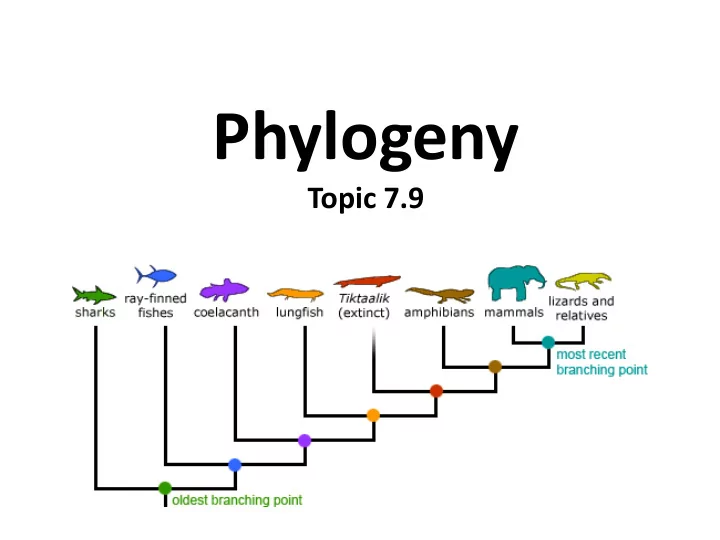

Phylogeny Topic 7.9
Phylogeny • Phylogeny is the evolutionary history of a species or a group of species • Goal of Phylogenetics: the resulting phylogeny should match taxonomy (classification of an organism)
Phylogeny and Classification
Phylogenetic Tree or Cladogram • Constructed using morphological similarities (homologies) of living or fossil species, DNA and protein sequences • Molecular data typically provide more accurate and reliable evidence than morphological traits
Molecular Evidence Morphological Evidence (or pre-molecular data) Chimpanzee is more closely related to Apes are more closely humans than other apes related to each other than they are to humans
Trees are Hypotheses • Phylogenetic trees and cladograms represent hypotheses about the evolutionary history of and relationships between groups of organisms • Trees are dynamic - constantly being revised based on new evidence
Dinosaur Tree Revision • Tree was revised based on research conducted on the hip bones of dinosaur fossils • “Previous tree” hypothesis existed for 130 years
Understanding Phylogenies • Click on the hyperlink above to learn about phylogenetic trees • Read the first page and then click “next” at the bottom of the page for page 2 of Understanding Phylogenies
Tree Terminology
Tree Terminology • Sister taxa – groups of organisms that share an immediate common ancestor • Node (branch point) – represents the most recent common ancestor of a group • Root – single branch point from which all branches originate in the tree
Rooted versus Unrooted Trees
Phylogenetic Trees vs Cladograms • Both diagrams show relationships between lineages • Phylogenetic trees show the amount of genetic change over time calibrated by fossils or a molecular clock • Cladograms do not show time Phylogenetic Cladogram Tree
What is a clade? • A clade is a group of organisms that consists of a common ancestor and all of its descendants
Monophyletic Group • A clade is also known as a monophyletic group
Character • Characters are heritable traits that can be compared across organisms, such as physical characteristics (morphology), genetic sequences, and behavioral traits • Example: wings shown below
Derived versus Ancestral Characters • A shared, derived character is one that evolved in one group but not in the other group (a new trait or evolutionary novelty) • An ancestral character is thought to have evolved in a common ancestor of both groups
Derived versus Ancestral Characters • Identify a shared, derived character for mammals • Identify an ancestral character for mammals
Example of a Derived Trait • Number of heart chambers in animals • Tbx5 protein influences the formation of two ventricles in bird and mammalian hearts
Trees Show Speciation Events and Relatedness • Examine common ancestry in order to determine relatedness • Who is species 5 most closely related to?
Out-group • The out-group represents the lineage that is least closely related to the remainder of the organisms in the phylogenetic tree or cladogram • Used as a point of comparison for the in-group
Out-group versus In-group
Phylogenetic Trees May Show Extinct Lineages
Phylogenetic Trees Show Amount of Genetic Change Over Time
Phylogenetic Trees Based on Molecular Sequence Data • Use of molecular (i.e. DNA, amino acids) genetics to determine evolutionary relationships • Disadvantages? – Need common genes between species – Gene sequences need to be “aligned” first
Sequence Alignment (This is a tutorial on sequence alignment) • The goal of sequence alignment is to maximize the number of matching nucleotides in all compared sequences • Scientists compare SNPs and Indels
SNPs and Indels • SNPs – single nucleotide polymorphisms • Indels – insertions and deletions
Maximum Parsimony • Maximum parsimony – the simplest explanation that is consistent with the facts • Apply the principle of maximum parsimony when choosing a tree as a hypothesis • Choose the tree that requires the fewest evolutionary events or fewest amount of molecular changes There is a reason for this cat picture……
Which is the most parsimonious tree?
Constructing a Phylogenetic Tree • May require the use of a character table • + or 1 indicates the presence of the character, - or 0 indicates the absence of the character
Now You Try It • Based on the shared, derived characters in the table below, build a tree of the most likely evolutionary history of these organisms • + (present), - (absent)
Stop taking notes when you get to this slide
Recommend
More recommend